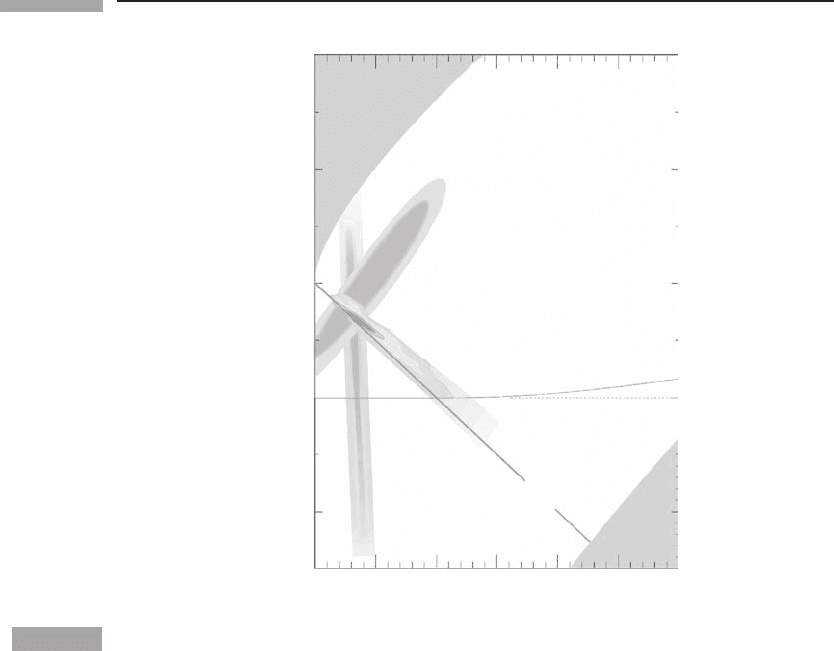Schutz B. A first course in general relativity
Подождите немного. Документ загружается.


353 12.3 Cosmological dynamics: understanding the expanding universe
t
the expansion should be slowing down. Instead it speeds up. What can be the cause of this
repulsion? We shall return to this question repeatedly through the rest of this chapter.
12.3 C os m ol o gic a l d y na m ic s : u nd e rst an d i ng t h e
expanding universe
In the last section we saw how to describe a homogeneous and isotropic universe and how
to measure its expansion. In order to study the evolution of the universe, to understand
the creation of the huge variety of structures that we see, and indeed to make sense of
the accelerating expansion measured today, we have to apply Einstein’s equations to the
problem, and to marry them with enough physics to explain what we see. In this section
we will study Einstein’s equations, with relatively simple perfect-fluid physics and with the
cosmological constant that seems to be implied by the expansion. In the following sections
we will study more and more of cosmological physics.
Dynamics of Robertson–Walker universes: Big Bang
and dark energy
We have seen that a homogeneous and isotropic universe must be described by one of the
three Robertson–Walker metrics given by Eq. (12.13). For each choice of the curvature
parameter k = (−1, 0, +1), the evolution of the universe depends on just one function of
time, the scale factor R(t). Einstein’s equations will determine its behavior.
As in earlier chapters, we idealize the universe as filled with a homogeneous perfect
fluid. The fluid must be at rest in the preferred cosmological frame, for otherwise its veloc-
ity would allow us to distinguish one spatial direction from another: the universe would
not be isotropic. Therefore, the stress-energy tensor will take the form of Eq. (4.36)inthe
cosmological rest frame. Because of homogeneity, all fluid properties depend only on time:
ρ = ρ(t), p = p(t), etc.
First we consider the equation of motion for matter, T
μν
;ν
= 0, which follows from the
Bianchi identities of Einstein’s field equations. Because of isotropy, the spatial components
of this equation must vanish identically. Only the time component μ = 0 is nontrivial. It is
easy to show (see Exer. 14, § 12.6) that it gives
d
dt
-
ρR
3
.
=−p
d
dt
-
R
3
.
, (12.46)
where R(t) is the cosmological expansion factor. This is easily interpreted: R
3
is propor-
tional to the volume of any fluid element, so the left-hand side is the rate of change of its
total energy, while the right-hand side is the work it does as it expands (−p d V).

354 Cosmology
t
There are two simple cases of interest, a matter-dominated cosmology and a radiation-
dominated cosmology. In a matter-dominated era, which includes the present epoch, the
main energy density of the cosmological fluid is in cold nonrelativistic matter particles,
which have random velocities that are small and which therefore behave like dust: p = 0.
So we have
Matter-dom :
d
dt
-
ρR
3
.
= 0. (12.47)
In a radiation-dominated era (as we shall see, in the early universe), the principal energy
density of the cosmological fluid is in radiation or hot, highly relativistic particles, which
have an equation of state p =
1
3
ρ (Exer. 22, § 4.10). Then we get
Radiation-dom :
d
dt
(ρR
3
) =−
1
3
ρ
d
dt
(R
3
), (12.48)
or
Radiation-dom :
d
dt
-
ρR
4
.
= 0. (12.49)
The Einstein equations are also not hard to write down for this case. Isotropy will guar-
antee that G
tj
= 0 for all j, and also that G
jk
∝ g
jk
. That means that only two components
are independent, G
tt
and (say) G
rr
. But the Bianchi identity will provide a relationship
between them, which we have already used in deriving the matter equation in the previous
paragraph. (The same happened for the spherical star.) Therefore we only need compute
one component of the Einstein tensor (see Exer. 16, § 12.6):
G
tt
= 3(
˙
R/R)
2
+ 3k/R
2
. (12.50)
Therefore, besides Eqs. (12.47)or(12.49), we have only one further equation, the Einstein
equation with cosmological constant
G
tt
+ g
tt
= 8π T
tt
. (12.51)
Physicists today hope that they will eventually be able to compute the value of the cos-
mological constant from first principles in a consistent theory where gravity is quantized
along with all the other fundamental interactions. From this point of view, the cosmological
constant will represent just another contribution to the whole stress-energy tensor, which
can be given the notation
T
αβ
=−(/8π)g
αβ
. (12.52)
From this point of view, the energy density and pressure of the cosmological constant
‘fluid’ are

355 12.3 Cosmological dynamics: understanding the expanding universe
t
ρ
= /8π , p
=−ρ
. (12.53)
Cosmologists call ρ
the dark energy: an energy that is not associated with any known
matter field. Its associated dark pressure p
has the opposite sign. Physicists generally
expect that the dark energy will be positive, so that most discussions of cosmology today
are in the framework of ≥ 0. We will return below to the implications of the associated
negative value for the dark pressure. Notice that, as the universe expands, the dark energy
density and dark pressure remain constant. In these terms the tt-component of the Einstein
equations can be written
1
2
˙
R
2
=−
1
2
k +
4
3
πR
2
(ρ
m
+ ρ
), (12.54)
where now we write ρ
m
for the energy density of the matter (including radiation), to dis-
tinguish it from the dark energy density. This equation makes it easy to understand the
observed acceleration of our universe. It appears (see below) that k = 0, or at least that
the k-term is negligible. Then, since we are in a matter-dominated epoch, the term R
2
ρ
m
decreases as R increases, while the term R
2
ρ
increases rather strongly. Since today, as we
shall see below, ρ
>ρ
m
, the result is that
˙
R increases as R increases. This trend must con-
tinue now forever, provided the acceleration is truly propelled by a cosmological constant,
and not by some physical field that will go away later.
How, physically, can a positive dark energy density drive the universe into accelerated
expansion? Is not positive energy gravitationally attractive, so would it not act to slow down
the expansion? To answer this it is helpful to look at the spatial part of Einstein’s equations,
where there acceleration
¨
R explicitly appears. Rather than derive this from the Christoffel
symbols, we can use the fact that (as remarked above) it follows from the two basic equa-
tions we have already written down: Eq. (12.46) and the time-derivative of Eq. (12.54). In
Exer. 17, § 12.6 we show that the combination of these two equations implies the following
simple ‘equation of motion’ for the scale factor:
¨
R
R
=−
4π
3
(ρ +3p), (12.55)
where ρ and p are the total energy density and pressure, including both the normal matter
and the dark energy.
The acceleration is produced, not by the energy density alone, but by ρ + 3p.Wehave
met this combination before, in Exer. 20, § 8.6, where we called it the active gravitational
mass. We showed there that, in general relativity, when pressure cannot be ignored, the
source of the far-away Newtonian field is ρ + 3p, not just ρ. In the cosmological context,
the same combination generates the cosmic acceleration. It is clear that the negative pres-
sure associated with the cosmological constant can, if it is large enough, make this sum
negative, and that is what drives the universe faster and faster. Einstein’s gravity with a
cosmological constant has a kind of in-built anti-gravity!

356 Cosmology
t
Notice that a negative pressure is not by any means unphysical. Negative stress is called
tension, and in a stretched rubber band, for example, the component of the stress ten-
sor along the band is negative. Interestingly, our analogy using a balloon to represent the
expanding universe also introduces a negative pressure, the tension in the stretched rubber.
What is remarkable about the dark energy is that its tension is so large, and it is isotropic.
See Exer. 18, § 12.6 for a further discussion of the tension in this ‘fluid’.
Eq. (12.54) is written in a form that suggests studying the expansion of the universe in
a way analogous to the energy methods physicists use for particle motion (as we did for
orbits in Schwarzschild in Ch. 11). The left-hand side looks like a ‘kinetic energy’ and the
right-hand side contains a constant (−k/2) that plays the role of the ‘total energy’ and a
potential term proportional to R
2
(ρ
m
+ ρ
), which depends on R explicitly and through ρ
m
.
The dynamics of R will be constrained by this energy equation.
We can use this constraint to explore what might happen to our universe in the far dis-
tant future, assuming of course the Cosmological Principle, that nothing significantly new
comes over our particle horizon. If ρ
≥ 0 (see above) and if the matter content of the uni-
verse also has positive energy density, then one conclusion from Eq. (12.54) is immediate:
an expanding hyperbolic universe (k =−1) will never stop expanding. For the flat uni-
verse (k = 0), an expanding universe will also never stop if ρ
> 0; however, if ρ
= 0,
then it could asymptotically slow down to a zero expansion rate as R approaches infinity,
since the matter density will decrease at least as fast as R
−3
. An expanding closed universe
(k = 1) will, if ρ
= 0, always reach a maximum expansion radius and then turn around
and re-collapse, again because R
2
ρ
m
decreases with R. A re-collapsing universe eventually
reaches another singularity, called the Big Crunch! But if ρ
> 0, then the ultimate fate of
an expanding closed universe depends on the balance of ρ
m
and ρ
.
We can ask similar questions about the history of our universe: was there a Big Bang,
where the scale factor R had the value zero at a finite time in the past? First we consider
for simplicity ρ
= 0. Then Eq. (12.54) shows that, as R gets smaller, the matter term gets
more and more important compared to the curvature term −k/2. Again this is because R
2
ρ
m
is proportional either to R
−1
for matter-dominated dynamics or, even more extremely, to
R
−2
for the radiation-dominated dynamics of the very early universe. Therefore, since our
universe is expanding now, it could not have been at rest with
˙
R = 0atanytimeinthe
past. The existence of a Big Bang, i.e. whether we reach R = 0 at a finite time in the past,
depends only on the behavior of the matter; the curvature term is not important, and all
three kinds of universes have qualitatively similar histories.
Let us do the computation for a universe that is radiation-dominated, as ours will have
been at an early enough time, and that has = 0 for simplicity. We write ρ = BR
−4
for
some constant B, and we neglect k in Eq. (12.54). This gives
˙
R
2
=
8
3
πBR
−2
,
or
dR
dt
=
-
8
3
πB
.
1/2
R
−1
. (12.56)

357 12.3 Cosmological dynamics: understanding the expanding universe
t
This has the solution
R
2
=
-
32
3
πB
.
1/2
(t −T), (12.57)
where T is a constant of integration. So, indeed, R = 0 was achieved at a finite time in the
past, and we conventionally adjust our zero of time so that R = 0att = 0, which means
we redefine t so that T = 0.
Note that we have found that a radiation-dominated cosmology with no cosmological
constant has an expansion rate where R(t) ∝ t
1/2
. If we had done this computation for a
matter-dominated cosmology with ρ
= 0, we would have found R(t) ∝ t
2/3
(see Exer. 19,
§ 12.6).
What happens if there is a cosmological constant? If the dark energy is positive, there is
no qualitative change in the conclusion, since the term involving ρ
simply increases the
value of
˙
R at any value of R, and this brings the time where R = 0 closer to the present
epoch. If the matter density has always been positive, and if the cosmological constant is
non-negative, then Einstein’s equations make the Big Bang inevitable: the universe began
with R = 0 at a finite time in the past. This is called the cosmological singularity:the
curvature tensor is singular, tidal forces become infinitely large, and Einstein’s equations
do not allow us to continue the solution to earlier times. Within the Einstein framework we
cannot ask questions about what came before the Big Bang: time simply began there.
How certain, then, is our conclusion that the universe began with a Big Bang? First, we
must ask if isotropy and homogeneity were crucial; the answer is no. The ‘singularity theo-
rems’ of Penrose and Hawking (see Hawking and Ellis 1973) have shown that our universe
certainly had a singularity in its past, regardless of how asymmetric it may have been. But
the theorems predict only the existence of the singularity: the nature of the singularity is
unknown, except that it has the property that at least one particle in the present universe
must have originated in it. Nevertheless, the evidence is strong indeed that we all origi-
nated in it. Another consideration however is that we don’t know the laws of physics at
the incredibly high densities (ρ →∞) which existed in the early universe. The singularity
theorems of necessity assume (1) something about the nature of T
μν
, and (2) that Einstein’s
equations (without cosmological constant) are valid at all R.
The assumption about the positivity of the energy density of matter can be challenged
if we allow quantum effects. As we saw in our discussion of the Hawking radiation in the
previous chapter, fluctuations can create negative energy for short times. In principle, there-
fore, our conclusions are not reliable if we are within one Planck time t
Pl
= GM
Pl
/c
2
∼
10
−43
s of the Big Bang! (Recall the definition of the Planck mass in Eq. (11.111).) This
is the domain of quantum gravity, and it may well turn out that, when we have a quantum
theory of the gravitational interaction, we will find that the universe has a history before
what we call the Big Bang.
Philosophically satisfying as this might be, it has little practical relevance to the universe
we see today. We might not be able to start our universe model evolving from t = 0, but
we can certainly start it from, say, t = 100t
Pl
within the Einstein framework. The primary
uncertainties about understanding the physical cosmology that we see around us are, as
we will discuss below, to be found in the physics of the early universe, not in the time
immediately around the Big Bang.

358 Cosmology
t
So far we have restricted our attention to the case of a positive cosmological constant.
While this seems to be the most relevant to the evolution of our universe, cosmologies
with negative cosmological constant are also interesting. We leave their exploration to the
exercises.
Einstein introduced the cosmological constant in order to allow his equations to have a
static solution,
˙
R = 0. He did not know about the Hubble flow at the time, and he followed
the standard assumption of astronomers of his day that the universe was static. Even in the
framework of Newtonian gravity, this would have presented problems, but no-one seems
to have tried to find a solution until Einstein addressed the issue within general relativity.
We have to do more than just set
˙
R = 0inEq.(12.54); we have to guarantee that the
solution is an equilibrium one, that the dynamics won’t change
˙
R, i.e. that the universe is
at a minimum or maximum of the ‘potential’ we discussed earlier. We show in Exer. 20,
§ 12.6 that the static solution requires
ρ
=
1
2
ρ
0
.
For Einstein’s static solution, the dark energy density has to be exactly half of the matter
energy density. We shall see below that in our universe the measured value of the dark
energy density is about twice that of the matter energy density, so we are near to but not
exactly at Einstein’s static solution.
Critical density and the parameters of our universe
If we divide Eq. (12.54)by4π R
2
/3, we obtain a version that is instructive for discussions
of the physics of the universe:
3H
2
8π
=−
3k
8πR
2
+ ρ
m
+ ρ
, (12.58)
where we have substituted the Hubble parameter H for
˙
R/R. Since the last two terms on
the right are energy densities, it is useful to interpret the other terms in that way. Thus,
the Hubble expansion has associated with it an energy density ρ
H
= 3H
2
/8π, and the
spatial curvature parameter contributes an effective energy density ρ
k
=−3k/8π R
2
.This
equation becomes
ρ
H
= ρ
k
+ ρ
m
+ ρ
.
Now, if in the universe today the ‘physical’ energy density ρ
m
+ ρ
is less than the Hub-
ble energy density ρ
H
, then (as we have seen before), the curvature energy density must
be positive, the curvature parameter k must be negative, and the universe has hyperbolic
hypersurfaces. Conversely, if the physical energy density is larger than the Hubble energy
density, the universe will be the closed model. The Hubble energy density is therefore a
threshold, and we call it the critical energy density ρ
c
:
ρ
c
=
3
8π
H
2
0
. (12.59)

359 12.3 Cosmological dynamics: understanding the expanding universe
t
The ratio of any energy density to the critical is called with an appropriate subscript.
Thus, we can divide the earlier energy-density equation, evaluated at the present time, by
ρ
c
to get
1 =
k
+
m
+
. (12.60)
These are the quantities used to label the curves in Fig. 12.3. The data from supernovae,
the cosmic microwave background, and studies of the evolution of galaxy clusters (below)
all suggest that our universe at present has
= 0.7,
m
= 0.3,
k
= 0. (12.61)
These mean that we live in a flat universe, dominated by a positive cosmological constant.
What size do these numbers have? It is conventional among astronomers to normalize
the Hubble constant H
0
to the value 100 km s
−1
Mpc
−1
by introducing the scaled Hubble
constant h (nothing to do with gravitational wave amplitudes!):
h = H
0
/100 km s
−1
Mpc
−1
. (12.62)
The best value today is h = 0.71. Using this, the critical energy density is
ρ
c
= 1.88 × 10
−26
h
2
kg m
−3
= 9.5 ×10
−27
kg m
−3
.
As we have noted, the matter energy density is about 0.3 times this, and this is much more
than astronomers can account for by counting stars and galaxies. In fact, studies of the for-
mation of elements in the early universe (below) tell us that the density of baryonic matter
(normal matter made of protons, neutrons, and electrons) has
b
= 0.04. So most of the
matter in the universe is non-baryonic, does not emit light, and can be studied astronomi-
cally only indirectly, through its gravitational effects. This is called dark matter. So we can
split
m
into its components:
m
=
b
+
d
,
b
= 0.04,
d
= 0.26. (12.63)
We will return in § 12.4 below to a discussion of the nature and distribution of the dark
matter. The values in Eqs. (12.61) and (12.63) are commonly referred to as the concordance
cosmology.
The variety of possible cosmological evolutions and the data are captured in the diagram
in Fig. 12.4. The evidence is getting rather strong that the dark energy is present, and even
dominant. That raises new, important questions. The deepest is, where in physics does this
energy come from? We will mention below some of the speculations, but at present there
is simply no good theory for it. In such a situation, better data might help. For example,
astronomers could try to determine if the dark energy density really is constant in time (as
it would be if it comes from a cosmological constant) or variable, which would indicate

360 Cosmology
t
0
–1
0
1
2
3
123
Ω
M
Ω
M
Clusters
Flat
Open
Closed
CMB
Supernovae
No big bang
Expands forever
recollapses eventually
Supernova cosmology project
Knop et al. (2003)
Spergel et al. (2003)
Allen et al. (2202)
t
Figure 12.4
In the
m
v.
plane one sees the variety of possible cosmological models, their histories and
futures. The constraints from studies of supernovae (Knop et al. 2003), the cosmic microwave
background radiation (Spergel et al. 2003), and galaxy clustering (Allen et al. 2002) are
consistent with one another and all overlap in a small region of parameter space centered on
= 0.7 and
m
= 0.3. This means that
k
= 0 to within the errors. Figure courtesy the
Supernova Cosmology Project.
that it comes from some physical field masquerading as a cosmological constant. As of
this writing, new space and ground-based observing programs are being planned, so that in
another decade we might have a new generation of ultra-precise measurements of the dark
energy.
From the point of view of general relativity, one of the most intriguing ways of studying
the dark energy is with the LISA gravitational wave detector. As mentioned in § 9.5,LISA
will be able to observe coalescences of black holes at high redshifts and measure their
distances. What will be measured from the signal is the luminosity distance d
L
to the binary,
since it is based on an inference of the luminosity of the system in gravitational waves
from the information contained in the signal. This measurement can be made with great
accuracy, perhaps with errors at the few percent level. To do cosmography, we have to
combine these luminosity distance measures with redshifts, and that will not be easy: black
hole coalescences do not give off any electromagnetic radiation directly, so it will not be
easy to identify the galaxy in which the event has occurred. But the galaxies hosting the
mergers will not be normal galaxies, and the merger event might be accompanied by other

361 12.4 Physical cosmology: the evolution of the universe we observe
t
signs, such as an alteration of X-ray luminosity, the existence of unusual jets, a disturbed
morphology. It may well be possible in many cases to identify the host galaxy within
the LISA position error box, which may be less than 10 arcminutes in size in favorable
cases.
A gravitational-wave measurement would be a very desirable complement to other stud-
ies of the dark energy, because it needs no calibration: it would be independent of the
assumptions of the cosmic distance ladder. It would therefore be an important check on the
systematic errors of other methods.
12.4 P h ys i ca l co s mo l ogy : t h e e vo lu t ion
of the universe we observe
The observations described in the last section confirm the reliability of using a general-
relativistic cosmological model with dark energy to describe the evolution of the universe,
starting as far back as our observations can take us. During the last few decades, astro-
physicists have developed a deep and rich understanding of how the universe we see, with
all its structure and variety, evolved out of a homogeneous hot expanding plasma. The story
is a fascinating one that we can only sketch here. But it is fair to say that there is now a
consistent story that goes from the moment that protons and neutrons became identifiable
particles right up to the formation of stars like our Sun and planets like our Earth. Many
of the details are poorly understood, especially where observations are difficult to perform,
but the physical framework for understanding them is not in doubt.
The expansion of the universe was accompanied by a general cooling off of its matter:
photons have been redshifted, the random velocities of gas particles dropped, structures
like galaxies and stars condensed out. The history of the universe is therefore a thermal
history: instead of using cosmological time t or the scale factor R to mark different stages
of evolution, we will use temperature, or equivalently energy, converting between them by
E = kT. That brings us closer to the physics.
Our understanding of the history of the universe rests on our understanding of its physi-
cal laws, and these are tested up to energies of order 1 TeV in modern particle colliders. So
our physical picture of the evolution of the universe can reliably start when the expanding
plasma had that sort of energy.
Decoupling: forming the cosmic microwave
background radiation
If we start at the present moment and go backwards, the matter energy density increases
as the scale factor R decreases, but the dark energy density remains constant, so (unless
the dark energy comes from some exotic physics) we can safely ignore the dark energy at
early times. The density of ordinary matter (dark and baryonic) increases as R
−3
, while
the energy density of the photons of the cosmic microwave background increases as R
−4
.

362 Cosmology
t
Since the energy density of the cosmic microwave background today is
γ
∼ 10
−5
and the
matter density is
m
= 0.3, they will have been equal when the scale factor was a factor of
3 × 10
4
smaller than today. Since redshift and scale factor go together, this is the redshift
when the expanding universe changed from radiation-dominated to matter dominated. At
higher redshifts, the universe was radiation-dominated. The temperature was about 10
5
K
and the energy scale was about 10 eV. This happened about 3000 years after the Big Bang.
Now, this energy is near the ionization energy of hydrogen, which is 13.6 eV. This is
an important number because hydrogen is the principal constituent of the baryonic mat-
ter. If the temperature is high enough to ionize hydrogen, the universe will be filled with
a plasma that is opaque to electromagnetic radiation. Once hydrogen cools off enough to
become neutral, the remaining photons in the universe will be able to move through it with
a low probability of scattering. This moment of decoupling (also called recombination)
defines the moment at which the cosmic microwave background radiation was created.
This actually occurs at a rather smaller energy than 13.6 eV, since there is enough hydro-
gen to stop the photons even when only a small portion of it is ionized. The epoch of
decoupling occurred at a temperature a bit below 1 eV, at a time when the universe was
matter-dominated. The redshift was about 2000, and the time was about 4 × 10
5
years after
the Big Bang.
Observations of the cosmic microwave background reveal that it has an almost perfect
black-body spectrum with a temperature of T = 2.725K. But they also show that it has
small but significant temperature irregularities, departures from strict homogeneity that are
the harbingers of the formation of galaxy clusters and galaxies. A map of these is shown in
Fig. 12.5. The temperature irregularities are of order 10
−5
of the background temperature,
and they are caused by irregularities in the matter distribution of the same relative size.
Small as these may seem, numerical studies show that they are adequate to lead to all
the structure we see today. Because the dominant form of matter is the dark matter, the
density fluctuations that are seen in Fig. 12.5 and that led to galaxy formation were in its
t
Figure 12.5
A map of the small-scale temperature inhomogeneities of the cosmic microwave background,
made by the WMAP satellite (Spergel, et al, 2003). The range of fluctuations is ±200μK. Figure
courtesy the WMAP project and NASA.
.
